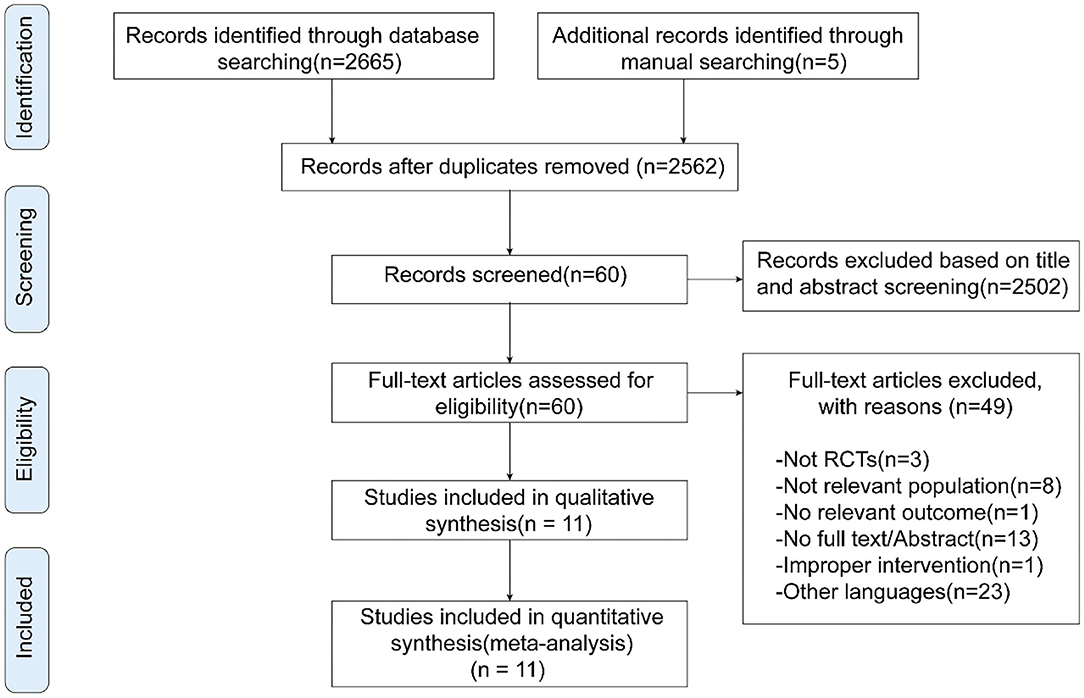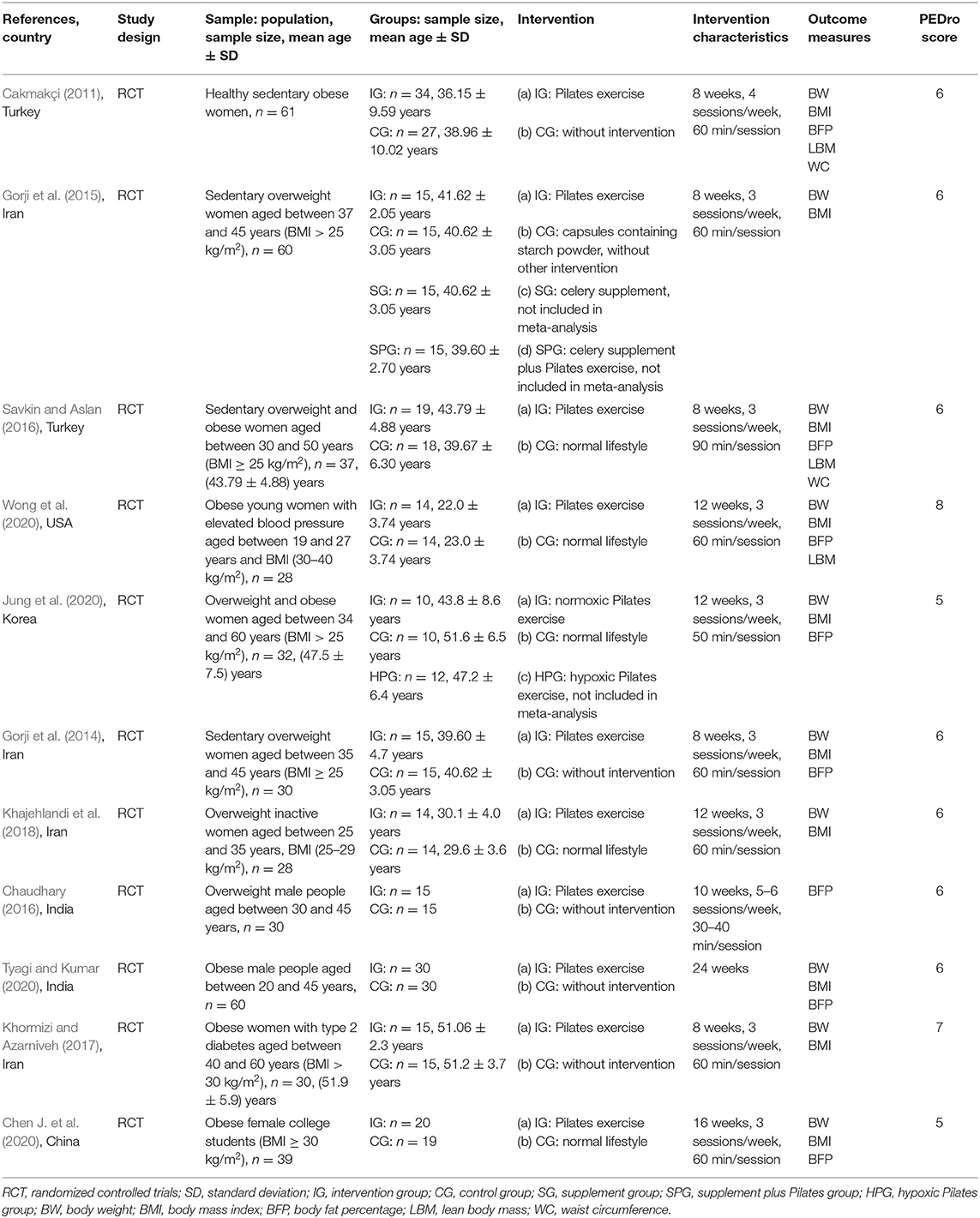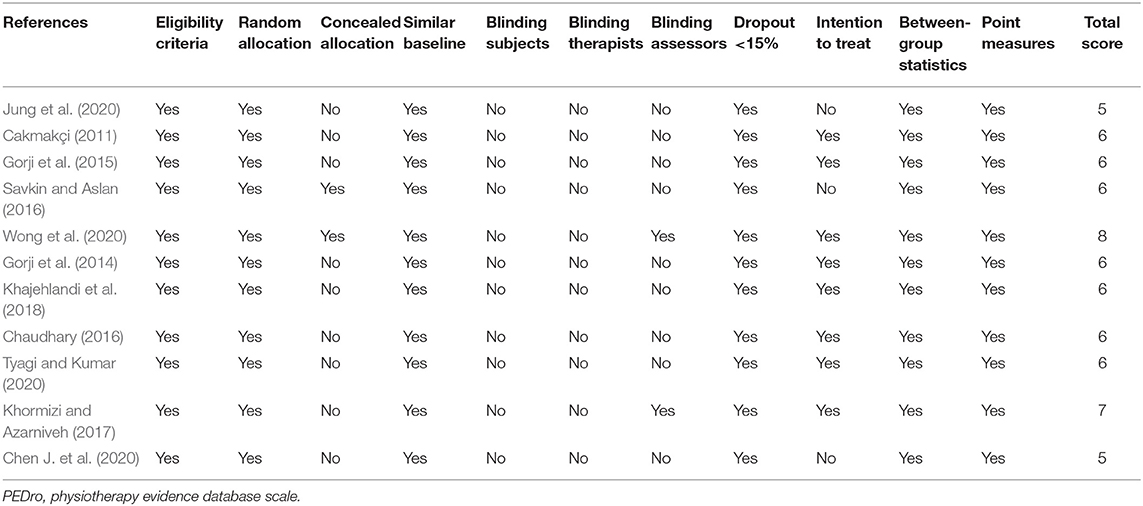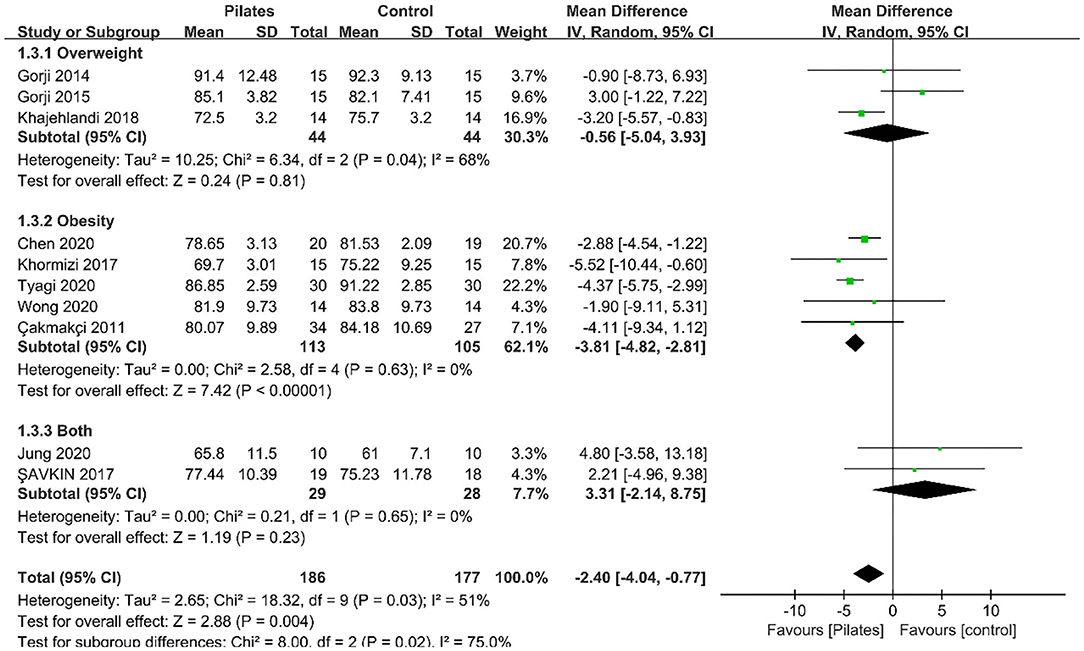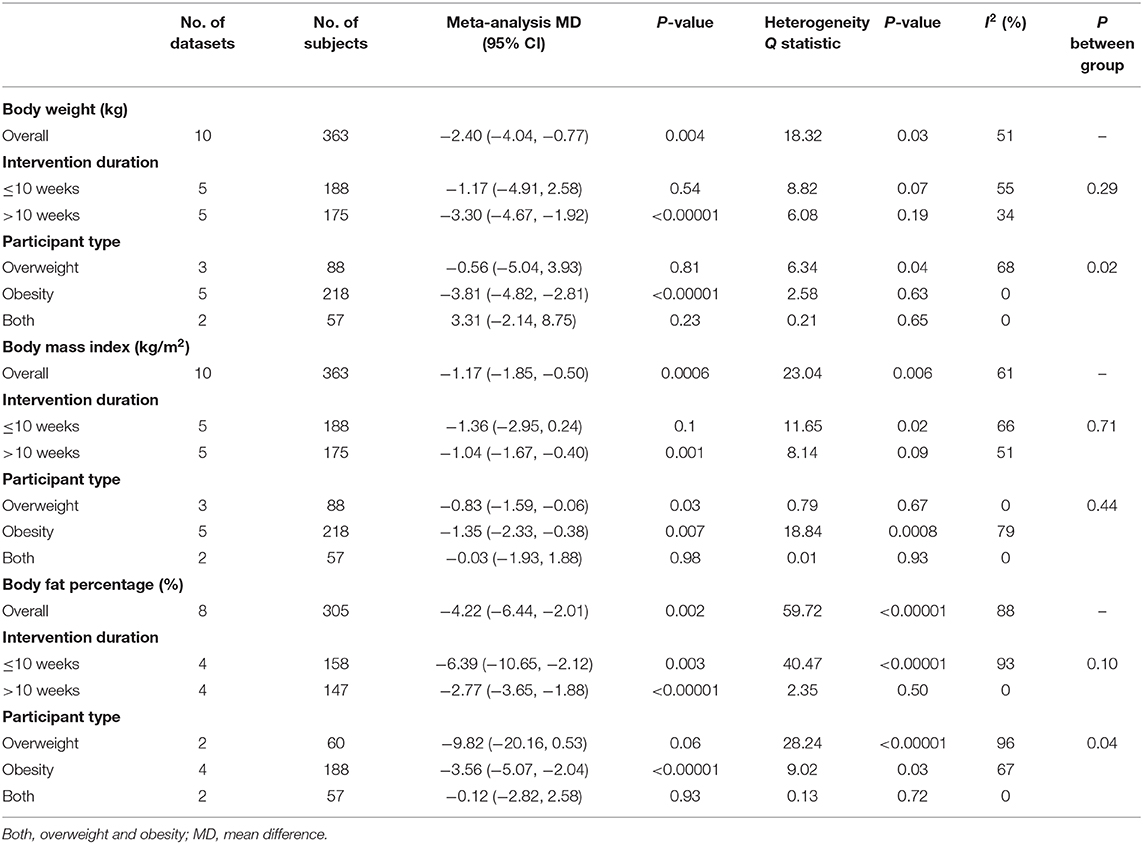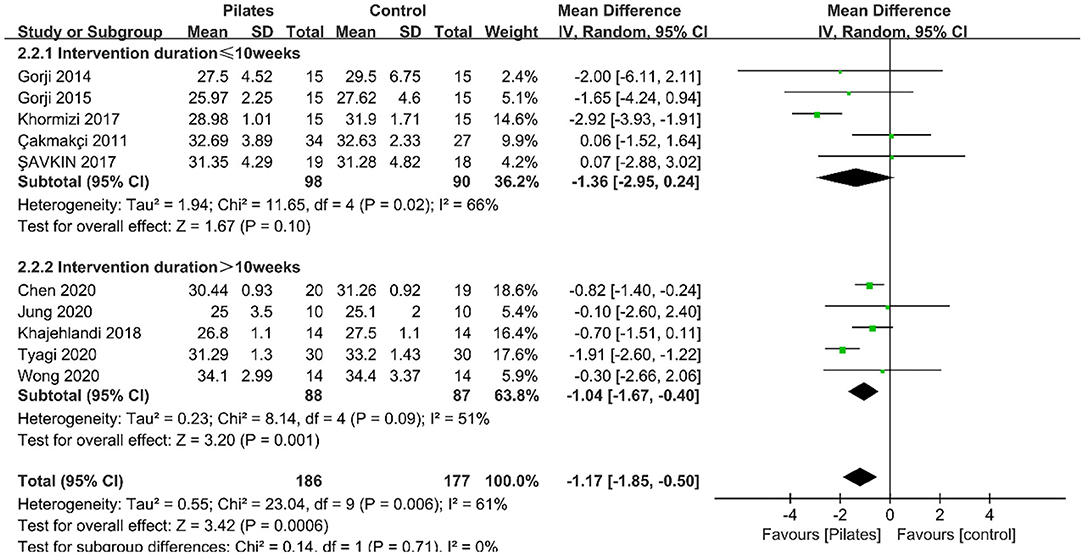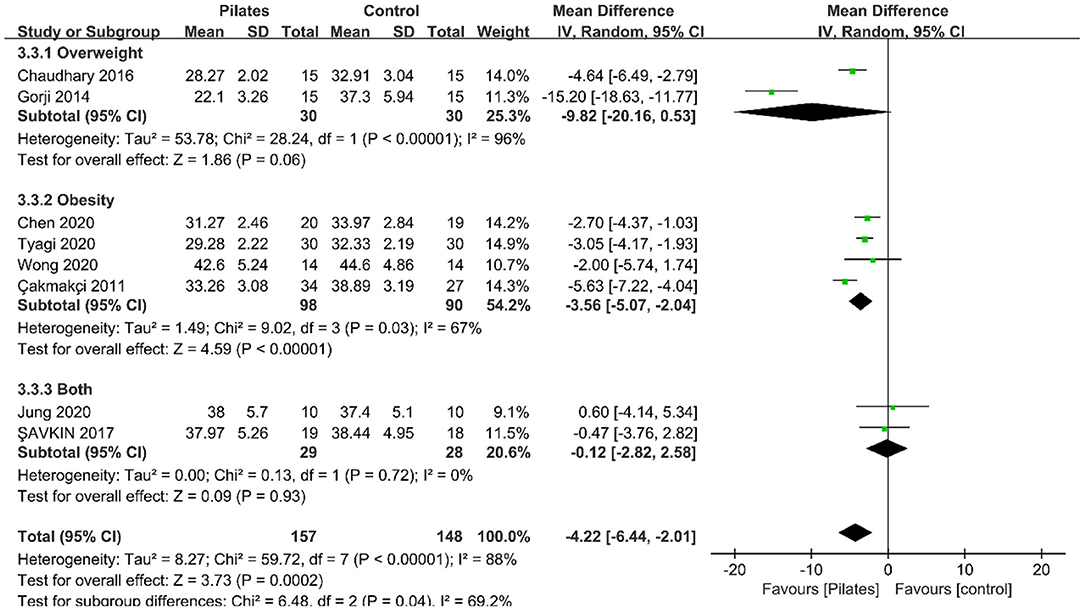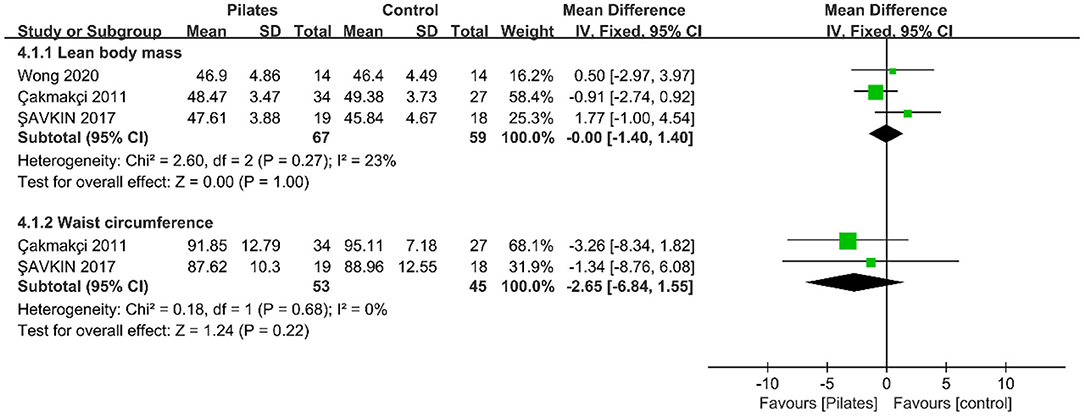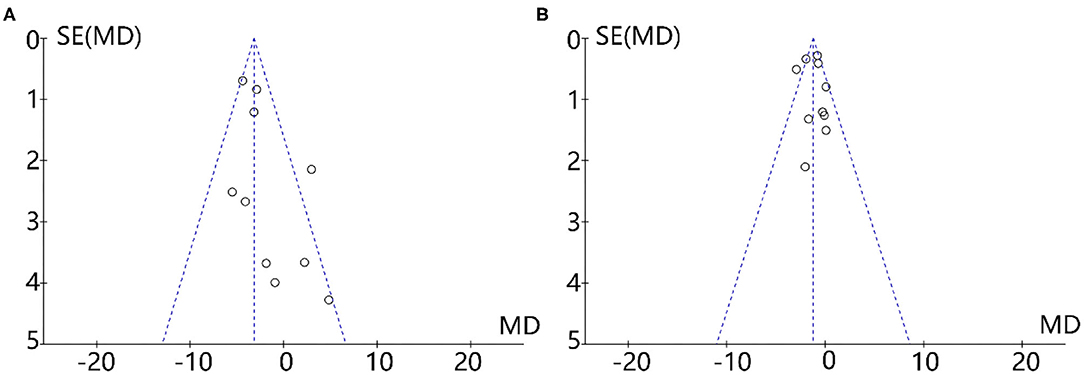- 1The Fifth Clinical Medical College of Guangzhou University of Chinese Medicine, Guangzhou, China
- 2Guangdong Second Traditional Chinese Medicine Hospital, Guangzhou, China
Background: Evidence for the efficacy of Pilates for the modulation of body weight and body composition is unclear.
Objective: This meta-analysis aimed to evaluate the effects of Pilates on body weight and body composition in adults with overweight or obesity.
Data Sources: The PubMed, Cochrane Library, Web of Science, China National Knowledge Infrastructure (CNKI), and EMBASE databases were systematically searched from the inception dates to 12 November 2020 for relevant randomized controlled trials (RCTs).
Study Selection: Randomized controlled trials comparing Pilates with other physical exercises or without any intervention were included.
Data Extraction and Synthesis: Three reviewers independently performed the data extraction and assessed study quality. The mean differences (MDs) and 95% confidence intervals (CIs) for pooled data were calculated.
Main Outcomes and Measures: Outcome measures were body weight, body mass index (BMI), body fat percentage, lean body mass, and waist circumference.
Results: Eleven RCTs with 393 subjects were included. This study revealed that Pilates dramatically reduces body weight (MD = −2.40, 95% CI: [−4.04, −0.77], P = 0.004, I2 = 51%), BMI (MD = −1.17, 95% CI: [−1.85, −0.50], P = 0.0006, I2 = 61%), and body fat percentage (MD = −4.22, 95% CI: [−6.44, −2.01], P = 0.0002, I2 = 88%) in adults with overweight or obesity. The reduction in body weight and body fat percentage appears to be more pronounced in studies including participants with obesity only, and the efficacy of Pilates for the improvement of body weight and BMI appears to be more evident in longer intervention duration. However, Pilates has no significant effect on waist circumference (MD = −2.65, 95% CI: [−6.84, 1.55], P = 0.22, I2 = 0%) and lean body mass (MD = −0.00, 95% CI: [−1.40, 1.40], P = 1.00, I2 = 23%).
Conclusions: Pilates dramatically reduces body weight, BMI, and body fat percentage in adults with overweight or obesity. Large-scale and well-designed RCTs with improved methodology and reporting are urgently needed to further confirm these results.
Introduction
Overweight and obesity, which are defined as abnormal or excessive body fat accumulation (World Health Organization, 2020), are the leading variable risk factors for chronic diseases and premature death (World Health Organization, 2018). According to the body mass index (BMI) (kg/m2), for adults, overweight is a BMI ≥ 25, whereas obesity is a BMI ≥ 30 (World Health Organization, 2020). Statistically, in 2016, 39% of adults aged 18 years and over were overweight, and 13% were obese; the prevalence of overweight and obesity among children and adolescents aged 5–19 was about 18%. Thirty-eight million children under the age of 5 were overweight or obese in 2019 (World Health Organization, 2020). Overweight and obesity have considerable negative socioeconomic impacts due to the high prevalence (Hammond and Levine, 2010). Besides excessive caloric intake, a sedentary lifestyle is also a major factor leading to overweight and obesity (Morgen and Sørensen, 2014). Therefore, regular physical activity has been recommended as one of the most effective prevention and treatment options for people with overweight or obesity (Expert Panel Members et al., 2014; World Health Organization, 2020). Given that some common physical exercises are ineffective in losing weight, and even may damage the musculoskeletal system due to knee joints overload in individuals with overweight or obesity (Girard et al., 2017; Hun-Young et al., 2019), it is necessary to investigate the alternative forms of exercise for treating overweight and obesity.
One such alternative modality of exercise that is widely used for health enhancement and adjuvant treatment in various diseases is Pilates (Sharma et al., 2018; Eliks et al., 2019; Fernández-Rodríguez et al., 2019). Pilates exercise, which was originated in the 1920s, mainly involved isometric contractions of the core muscles (Chen Z. et al., 2020). Moreover, the Pilates exercise system combined practical movement styles and ideas of martial arts, dance, gymnastics, and yoga with philosophical notions and followed six basic principles of centering, concentration, control, precision, flowing movements, and breathing (Latey, 2001). Pilates, although not designed to reduce body weight, can be considered a good option for people with overweight or obesity who have difficulty in adhering to those monotonous traditional physical exercises (Vancini et al., 2017; de Souza Cavina et al., 2020). Furthermore, Pilates does not require high costs to practice and produces high concentration in the muscle core, which could contribute to the implementation of this exercise method in clinical practice to improve body weight and body composition (de Souza Cavina et al., 2020). While the overall effects of physical exercises on body weight in people with overweight or obesity are now well-known, Pilates is not. Despite several studies have been conducted to assess the physical effects of Pilates for individuals with overweight or obesity, the results have been diverse with no clear consensus (Hagner-Derengowska et al., 2015; Rayes et al., 2019; Jung et al., 2020). Additionally, there is no systematic review or meta-analysis on Pilates for treating overweight and obesity to date. Therefore, the aim of this systematic review and meta-analysis of randomized controlled trials (RCTs) was to evaluate the effects of Pilates on body weight and body composition in adults with overweight or obesity.
Methods
Search Strategy
This review was conducted in accordance with the Preferred Reporting Items for Systematic Reviews and Meta-Analyses (PRISMA) guidelines (Moher et al., 2009). PubMed, the Cochrane Library, Web of Science, the China National Knowledge Infrastructure (CNKI), and EMBASE databases were systematically searched from the inception dates to 12 November 2020. We applied no language restrictions. We used the following combined text and MeSH terms: “Pilates,” “overweight and obesity,” and “Randomized Controlled Trial.” The complete search used for PubMed was: ((((((((((((((“Overweight” [Mesh]) OR (“Obesity” [Mesh])) OR (Overweight [Title/Abstract])) OR (Obesity [Title/Abstract])) OR (adipose tissue hyperplasia [Title/Abstract])) OR (adipositas [Title/Abstract])) OR (adiposity [Title/Abstract])) OR (alimentary obesity [Title/Abstract])) OR (body weight, excess [Title/Abstract])) OR (corpulency [Title/Abstract])) OR (fat overload syndrome [Title/Abstract])) OR (nutritional obesity [Title/Abstract])) OR (obesitas [Title/Abstract])) AND (((((((((“Exercise Movement Techniques” [Mesh]) OR (Movement Techniques, Exercise [Title/Abstract])) OR (Exercise Movement Technics [Title/Abstract])) OR (Pilates-Based Exercises [Title/Abstract])) OR (Exercises, Pilates-Based [Title/Abstract])) OR (Pilates Based Exercises [Title/Abstract])) OR (Pilates Training [Title/Abstract])) OR (Training, Pilates [Title/Abstract])) OR (Pilates [Title/Abstract]))) AND ((randomized controlled trial[pt] OR controlled clinical trial[pt] OR randomized[tiab] OR placebo[tiab] OR drug therapy[sh] OR randomly[tiab] OR trial[tiab] OR groups[tiab] NOT (animals [mh] NOT humans [mh]))). Additionally, the reference lists of all retrieved articles and relevant reviews were manually screened for potentially eligible studies. Two reviewers (Y Wang and ZH Chen) independently screened and selected papers, a third reviewer (ZG Wu) was consulted to resolve disagreements. The search strategy is detailed in Supplementary Table 1.
Selection Criteria
We formulated the study's eligibility criteria using the participants, interventions, comparison, outcomes, and study design (PICOS) description model (Guyatt et al., 2011).
Participants
Inclusion criteria:
• Adult subjects aged 18 or over with overweight or obesity (overweight, BMI ≥25.0 kg/m2; obesity, BMI ≥30.0 kg/m2)
Exclusion criteria:
• Pregnancy
• Participants with any contraindication of exercise therapy
• Participants with eating disorders
Intervention
• Pilates
No restrictions were made in terms of the type of Pilates, the duration, dose, or intensity of the intervention. Furthermore, studies with dietary intervention were excluded.
Comparators
• Pilates vs. other physical exercises
• Pilates vs. without any intervention
Outcomes
The included studies had to assess at least one primary outcome related to body weight or body composition:
• Body weight
• Body mass index
• Body fat percentage
• Lean body mass
• Waist circumference
In addition, the safety of Pilates intervention was considered secondary outcomes.
Study Design
• RCTs
• Published in English or Chinese language
Data Extraction
Two reviewers (Y Wang and ZH Chen) independently extracted the following data from the included studies: participant characteristics (e.g., age, gender, year), study characteristics (e.g., author names, publication year, region, study design, intervention type, intervention characteristics, sample size), and related study outcomes. Any disputes were resolved by discussing with a third reviewer (ZG Wu). If necessary, the corresponding authors were contacted for additional information.
Quality Assessment
The methodological quality of included studies was assessed using the Physiotherapy Evidence Database (PEDro) scale (Maher et al., 2003; Macedo et al., 2010), which is used to assess the quality of RCTs with physical therapist interventions. The PEDro scale includes 10 items on random allocation, concealed allocation, similarly at baseline, subjects blinding, therapists blinding, assessors blinding, dropout rate <15%, intention to treat analysis, between-group statistical analysis, and point and variability measures; the score ranges from 0 to 10. A score ≥7 was considered “high quality,” a score of 5 or 6 was considered “moderate quality,” and ≤4 “poor quality” (de Souza Cavina et al., 2020). Moreover, the quality of evidence was assessed using the Grading of Recommendations Assessment, Development, and Evaluation System (GRADEprofiler, version 3.6; GRADE Working Group, 2004; Higgins et al., 2020). The assessment process was also conducted by two independent reviewers (Y Wang and ZH Chen), and the consensus approach was once again adopted.
Statistical Analysis
Review Manager (version 5.3) and Stata (version 13.0) were used to conduct statistical analyses. Data were presented as mean ± standard deviation (SD) or 95% confidence interval (CI). All continuous variables were pooled by mean difference (MD) or MD with 95% CI. Heterogeneity was assessed by Higgins I2 statistic and 0–25% suggests very low heterogeneity, 25–50% low heterogeneity, 50–75% moderate heterogeneity, and more than 75% high heterogeneity (Higgins and Thompson, 2002; Higgins et al., 2020). The fixed effect models would be enabled if I2 < 50%; otherwise, a random-effect model was applied. To explore potential sources of heterogeneity between studies, subgroup and meta-regression analyses were conducted based on intervention duration and participant type. Sensitivity analyses were used to test the robustness of significant results. In addition, the visual inspection of funnel plots and statistical asymmetry tests (Begg's and Egger's tests) were used to assess publication bias. Statistical significance was considered for P < 0.05.
Results
Study Selection
A total of 2,670 potentially relevant records were acquired via electronic and hand search. We imported all the literature into EndNote X9 (Bld,12062) for de-duplication. Then we initially screened out 2,502 articles through title and abstract, and the remaining 60 were considered highly relevant. Finally, we further excluded 49 studies by means of reading full text according to our study selection criteria, leaving 11 studies (Cakmakçi, 2011; Gorji et al., 2014, 2015; Chaudhary, 2016; Savkin and Aslan, 2016; Khormizi and Azarniveh, 2017; Khajehlandi et al., 2018; Chen J. et al., 2020; Jung et al., 2020; Tyagi and Kumar, 2020; Wong et al., 2020) for inclusion in this analysis (Figure 1).
Study Characteristics
All included studies were RCTs involving 393 adults with overweight or obesity. The studies were from Korea (Jung et al., 2020), Turkey (Cakmakçi, 2011; Savkin and Aslan, 2016), Iran (Gorji et al., 2014, 2015; Khormizi and Azarniveh, 2017; Khajehlandi et al., 2018), the USA (Wong et al., 2020), India (Chaudhary, 2016; Tyagi and Kumar, 2020), and China (Chen J. et al., 2020). These studies were published between 2011 and 2020, and the intervention duration varied from 8 to 24 weeks, with the sample size ranging from 20 to 61 participants. The participants were mostly female (77.1%). Nine studies (81.8%) only recruited women (Cakmakçi, 2011; Gorji et al., 2014, 2015; Savkin and Aslan, 2016; Khormizi and Azarniveh, 2017; Khajehlandi et al., 2018; Chen J. et al., 2020; Jung et al., 2020; Wong et al., 2020), and another two (18.2%) only recruited men (Chaudhary, 2016; Tyagi and Kumar, 2020). In terms of the definition of overweight and obesity, all 11 studies used BMI. Three studies recruited participants with hypertension (Wong et al., 2020), type 2 diabetes (Khormizi and Azarniveh, 2017), and depression (Chen J. et al., 2020), other studies recruited participants with no reported existing medical conditions. Regarding the measurement method of body composition, four studies (Gorji et al., 2014, 2015; Savkin and Aslan, 2016; Wong et al., 2020) used bioelectric impedance analysis device, three studies (Chaudhary, 2016; Khajehlandi et al., 2018; Tyagi and Kumar, 2020) used body composition analyzer, one study (Jung et al., 2020) used a dual-energy X-ray absorptiometry scanner, two studies (Cakmakçi, 2011; Chen J. et al., 2020) did not specify, and the remaining one (Khormizi and Azarniveh, 2017) did not measure. The characteristics of the included studies are summarized in Table 1.
Risk of Bias in Included Studies
The PEDro assessment indicated that the methodological quality of included studies was moderate (mean score = 6.09 ± 0.83; Table 2). All studies randomly allocated subjects, but only two studies (Savkin and Aslan, 2016; Wong et al., 2020) used concealed allocation. None of the studies employed subjects blinding and therapists blinding. However, only two studies (Khormizi and Azarniveh, 2017; Wong et al., 2020) used assessor blinding, which could lead to potential limitations. In addition, none of the studies had a loss to follow-up rate of more than 15%, and no study used intention-to-treat analysis.
Analysis of Overall Effect Size
Primary Outcomes
Body Weight
Ten studies recorded body weight outcomes. Meta-analysis results showed that Pilates significantly reduced body weight (MD = −2.40, 95% CI: [−4.04, −0.77], P = 0.004). Moderate heterogeneity was detected between studies (P = 0.03, I2 = 51%; Figure 2). Therefore, we conducted subgroup analyses for the results. Subgroup analysis based on intervention duration showed that a significant decrease was observed on body weight in studies with more than 10 weeks of duration (MD = −3.30, 95% CI: [−4.67, −1.92], P < 0.00001, I2 = 34%); whereas, no significant effect in studies with duration of 10 weeks or less (MD = −1.17, 95% CI: [−4.91, 2.58], P = 0.54, I2 = 55%). Moreover, the subgroup analysis according to participant type demonstrated that body weight dramatically decreased by Pilates in studies including participants with obesity only (MD = −3.81, 95% CI: [−4.82, −2.81], P < 0.00001, I2 = 0%), and no statistically significant effect in another two groups. The results of subgroup analyses are summarized in Table 3. Meta-regression analyses on body weight indicated that the intervention duration (β = −0.612, P = 0.189) and participant type (β = −0.16, P = 0.654) were not related to interstudy heterogeneity.
Body Mass Index
Ten studies recorded outcomes for BMI. Meta-analysis results indicated that Pilates remarkably decreased BMI (MD = −1.17, 95% CI: [−1.85, −0.50], P = 0.0006) and a moderate heterogeneity was detected between studies (P = 0.006, I2 = 61%; Figure 3). Subgroup analysis based on intervention duration revealed that a significant reduction was observed on BMI in studies with more than 10 weeks of duration (MD = −1.04, 95% Cl: [−1.67, −0.40], P = 0.001, I2 = 51%); however, no significant effect in studies with duration of 10 weeks or less (MD = −1.36, 95% Cl: [−2.95, 0.24], P = 0.10, I2 = 66%). Additionally, the subgroup analysis according to participant type demonstrated that a remarkable decrease on BMI in studies including participants with overweight only or ones with obesity only (Table 3), which may be the reason for the excessive individual differences. Meta-regression analyses on BMI showed that the intervention duration (β = −0.142, P = 0.761) and participant type (β = −0.17, P = 0.613) were not correlated to interstudy heterogeneity.
Body Fat Percentage
Eight studies recorded outcomes for body fat percentage (BFP). Meta-analysis results revealed that Pilates significantly reduced BFP (MD = −4.22, 95% CI: [−6.44, −2.01], P = 0.0002), but a high heterogeneity was detected between studies (P < 0.00001, I2 = 88%; Figure 4). The subgroup analysis according to participant type revealed that a significant reduction on BFP in studies including participants with obesity only (MD = −3.56, 95% CI: [−5.07, −2.04], P < 0.00001, I2 = 67%), and no statistically significant effect in another two groups (Table 3).
Lean Body Mass and Waist Circumference
The analysis of three studies indicated that no significant effect on lean body mass (LBM) after Pilates (MD = −0.00, 95% CI: [−1.40, 1.40], P = 1.00), and a very low heterogeneity was seen between studies (P = 0.27, I2 = 23%). In addition, the meta-analysis of two studies demonstrated that waist circumference (WC) did not decrease after Pilates (MD = −2.65, 95%CI: [−6.84, 1.55], P = 0.22, I2 = 0%; Figure 5).
Secondary Outcomes
We considered safety as secondary outcomes in this study; however, no adverse events following Pilates intervention were reported in the included studies.
Sensitivity Analysis
The leave-one-out approach was used for sensitivity analysis of each outcomes (Patsopoulos et al., 2008; Supplementary Table 2). The analysis results indicated that the meta-analysis results for BMI and BFM did not alter when each study was removed in turn, and that the findings were robust. In the meta-analysis of BMI outcome, the removal of studies conducted by Khormizi and Azarniveh (2017) significantly reduced the heterogeneity, suggesting that this study could be the potential source of heterogeneity. Additionally, the meta-analysis results for body weight changed from significant (P < 0.05) to non-significant (P = 0.06) when the study by Chen J. et al. (2020) was removed, suggesting that this study was primarily responsible for the between-study heterogeneity.
Publication Bias
Visual inspection of funnel plots revealed no asymmetry (Figure 6), and the results from Egger's and Begg's test indicated that no evidence for publication bias was detected for body weight (Begg's test, P = 0.59; Egger's test, P = 0.35) and BMI (Begg's test, P = 0.37; Egger's test, P = 0.55).
Quality of Evidence
Regarding the assessment of the quality of evidence, there is low to moderate evidence in body weight and BMI, very low to low evidence in BFP, low evidence in lean body mass, and moderate evidence in waist circumference. This indicates that more researches may have a significant impact on the results of the effect estimate and even may change the results. The detailed information was presented in Supplementary Table 3.
Discussion
Summary of Main Results
We performed this study to evaluate scientific evidence for the efficacy of Pilates in improving body weight and body composition in adults with overweight or obesity. The analyses combined 11 studies involving a total of 393 adults with overweight or obesity (90 men and 303 women). Outcome measures were body weight, BMI, BFP, lean body mass, and WC. Overall results revealed that Pilates leads to a significant decrease in body weight, BMI, and BFP in adults with overweight or obesity. The reduction in body weight and BFP appears to be more pronounced in studies including participants with obesity only, and the efficacy of Pilates for the improvement of body weight and BMI appears to be more evident in longer intervention duration. These findings could have significant implications for the promotion of exercise interventions for overweight and obesity management. We also found that Pilates has no remarkable effect on WC and lean body mass. However, given the low to moderate overall quality of the evidence, we are still unable to draw a definite conclusion. Furthermore, since no trials reported adverse events, we could not judge the safety of Pilates.
Comparison With Other Reviews
To our knowledge, this is the first systematic review and meta-analysis to investigate the effects of Pilates on body weight and body composition in adults with overweight or obesity. In the previous reviews, few studies systematically analyzed and assessed the effects of Pilates on body weight and body composition. Aladro-Gonzalvo et al. (2012) conducted a systematic review to determine the effects of Pilates on body composition in several populations; the results suggested that there is insufficient evidence indicating a positive effect of Pilates on body weight and body composition. This finding is inconsistent with our review, and the main reason that might explain this is the poor methodological quality of the included studies. In another systematic review (Kamioka et al., 2016), there was some evidence that Pilates could reduce body fat and increase fat free mass. Although this is partially consistent with our findings, the authors of this review did not perform a meta-analysis, which limited the comparison with our review. The most recent review (de Souza Cavina et al., 2020) showed no evidence for the efficacy of Pilates in improving body weight and body composition in general population including overweight and obese individuals; the results conflicted with our present review, and insufficient training intensity and not performing diet control could be the main reasons for these results.
How the Intervention Might Work
Overweight and obesity, which are serious public health problems worldwide, are associated with many comorbidities such as insulin resistance and diabetes (Diabetes Prevention Program Research Group, 2002; Look AHEAD Research Group, 2003), hypertension and cardiovascular disease (Ozbey et al., 2002), metabolic syndrome (Frank et al., 2005), depression, and also cancer (Field et al., 2001). While overweight and obesity are being prevented and treated worldwide, they continue to be highly prevalent conditions that impose a substantial economic burden (Kushner and Kahan, 2018). Therefore, growing attention has been poured to the problems of body weight and a mounting number of medical staff have attached importance to develop available and affordable therapies for reducing body weight. Some studies indicated that exercise could improve the functions of several body systems, thereby improving body weight, body composition, cardiometabolic risk factors, and emotional health status (Jakicic et al., 2018; Garber, 2019), so exercise is widely used to reduce body weight in clinical practice. As for Pilates, it is often considered an alternative form of exercise. It was reported that completion of 30–45 min Pilates exercise could produce sufficient stimuli to induce positive changes in energy expenditure, thus reducing body weight (Olson et al., 2004). Moreover, since Pilates exercise involves employing different types of resistance (Lange et al., 2000), it could enhance the muscle strength of upper body parts, lower body parts, and abdomen (Bergamin et al., 2015) and could thus contribute to improving body composition. Besides exercise, Pilates also involves relaxation, concentration, and breath control. Thus, Pilates has been shown to effectively improve depression and anxiety (Vancini et al., 2017; Fleming and Herring, 2018; Aibar-Almazán et al., 2019), which might in turn improve overweight or obesity caused by emotional factors (Jantaratnotai et al., 2017).
Limitations
However, this present review had several potential limitations. Firstly, the overall effect sizes could have been affected by lack of concealed allocation (9 out of 11 studies), inability to use therapists/subjects blinding (all studies) or assessors blinding (9 out of 11 studies). Secondly, publication bias might have been a factor, as this review retrieved only relevant articles in the English and Chinese language within a limited number of electronic databases. Thirdly, given the small size of overall samples, some conclusions should be considered preliminary and even might be biased. Fourthly, there was a moderate to high heterogeneity between studies, while several subgroup analyses could explain the heterogeneity to some extent; however, considerable heterogeneity remained unclear. This may be partially because of the differences in participants (e.g., age, gender, race, lifestyle), Pilates intervention (e.g., exercise modalities, duration, dose, intensity), and the measuring method of outcomes. In addition, it remained unclear whether Pilates was more effective than other exercises for improving body weight and body composition as the included studies did not involve other exercise interventions.
Implications for Clinical Practice
This present meta-analysis showed that Pilates could improve body weight, BMI, and BFP in adults with overweight or obesity. Although the methodological quality of the included RCTs is poor, Pilates could still be preliminarily considered an effective intervention to treat overweight and obesity. It has been shown that people with overweight or obesity find it difficult to adhere to physical activities targeting weight loss (Burgess et al., 2017), mainly due to the monotony of physical activities (Vancini et al., 2017); these people are however more likely to practice Pilates (de Souza Cavina et al., 2020). Therefore, Pilates could be specifically considered an alternative to other forms of physical exercise for overweight or obese people who do not abide by recommended physical exercise regimens.
Implications for Further Research
Given the poor methodological quality of the majority of RCTs and the limited strength of evidence, more rigorous and robust methods are recommended to use in future studies. Firstly, the reporting of future Pilates RCTs should be improved and strictly follow standard reporting guidelines such as CONSORT (Schulz et al., 2010). Secondly, future RCTs should further ensure the use of concealed allocation, therapists/subjects blinding, intention-to-treat analysis, and assessors blinding. Thirdly, to reduce potential publication bias, the researchers are recommended to register beforehand in the clinical trial registry before recruiting participants. Fourthly, there were no adverse events described in any of the included studies, considering that safety is critical to the evaluation of therapies, future RCTs should improve the reporting of safety. Fifthly, future RCTs should compare Pilates with other interventions (e.g., aerobic exercise, resistance exercise) to evaluate the potential benefits of Pilates for overweight and obesity. In addition, there is evidence that diet and exercise play an important role in weight loss and promoting positive changes in body composition (Clark, 2015). Considering that diet is an uncontrollable factor, in order to eliminate the significant interference of diet on the results, we excluded studies with dietary intervention in this study to determine the effects of Pilates on body weight and body composition in adults with overweight or obesity. Some studies demonstrated that dietary intervention plus exercise resulted in an even greater reduction in body weight and body composition profile parameters than dietary interventions alone (Figueroa et al., 2013; Cheng et al., 2018). In view of this, it remained uncertain whether Pilates plus diet intervention was more effective than Pilates interventions alone in improving body weight and body composition, and further researches are needed to confirm it.
Conclusion
In conclusion, this present study indicated that Pilates lead to a remarkable decrease in body weight, BMI, and BFP in adults with overweight or obesity. No significant effect on WC and LBM. Large-scale and well-designed RCTs with improved methodology and reporting are recommended to further elucidate the effectiveness of Pilates for treating overweight and obesity.
Data Availability Statement
The original contributions presented in the study are included in the article/Supplementary Material, further inquiries can be directed to the corresponding author/s.
Author Contributions
YW and XX conceived and designed the study. YW and ZC performed the literature search, data extraction, and data analysis. ZW and XY helped with the data analysis and reviewed the manuscript for important content. XX supervised the study. All authors have read and approved the final version of the submitted version.
Funding
This work was supported by Soft Science Research Project of Guangdong Province (No. 2018B020207009) and Science and Technology Plan Project of Guangdong Province (2019A141401008).
Conflict of Interest
The authors declare that the research was conducted in the absence of any commercial or financial relationships that could be construed as a potential conflict of interest.
Supplementary Material
The Supplementary Material for this article can be found online at: https://www.frontiersin.org/articles/10.3389/fphys.2021.643455/full#supplementary-material
References
Aibar-Almazán, A., Hita-Contreras, F., Cruz-Díaz, D., de la Torre-Cruz, M., Jiménez-García, J. D., and Martínez-Amat, A. (2019). Effects of Pilates training on sleep quality, anxiety, depression and fatigue in postmenopausal women: a randomized controlled trial. Maturitas 124, 62–67. doi: 10.1016/j.maturitas.2019.03.019
Aladro-Gonzalvo, A. R., Machado-Díaz, M., Moncada-Jiménez, J., Hernández-Elizondo, J., and Araya-Vargas, G. (2012). The effect of Pilates exercises on body composition: a systematic review. J. Bodyw. Mov. Ther. 16, 109–114. doi: 10.1016/j.jbmt.2011.06.001
Bergamin, M., Gobbo, S., Bullo, V., Zanotto, T., Vendramin, B., Duregon, F., et al. (2015). Effects of a Pilates exercise program on muscle strength, postural control and body composition: results from a pilot study in a group of post-menopausal women. Age 37, 1–8. doi: 10.1007/s11357-015-9852-3
Burgess, E., Hassmén, P., Welvaert, M., and Pumpa, K. L. (2017). Behavioural treatment strategies improve adherence to lifestyle intervention programmes in adults with obesity: a systematic review and meta-analysis. Clin. Obes. 7, 105–114. doi: 10.1111/cob.12180
Cakmakçi, O. (2011). The effect of 8 week plates exercise on body composition in obese women. Coll. Anthropol. 35, 1045–1050.
Chaudhary, S. (2016). Role of Pilates exercises to reduce body fat percentage of overweight people. Indian J. Phys. Educ. Sports Appl. Sci. 10.
Chen, J., Li, Y., Wu, Y., and Su, X. (2020). Effects of Pilates exercise on body composition and serum inflammatory factors in obese female college students with depression. Chin. J. Sch. Health. 41, 783–786. doi: 10.16835/j.cnki.1000-9817.2020.05.040
Chen, Z., Ye, X., Shen, Z., Chen, G., Chen, W., He, T., et al. (2020). Effect of pilates on sleep quality: a systematic review and meta-analysis of randomized controlled trials. Front. Neurol. 11:158. doi: 10.3389/fneur.2020.00158
Cheng, C. C., Hsu, C. Y., and Liu, J. F. (2018). Effects of dietary and exercise intervention on weight loss and body composition in obese postmenopausal women: a systematic review and meta-analysis. Menopause 25, 772–782. doi: 10.1097/GME.0000000000001085
Clark, J. E. (2015). Diet, exercise or diet with exercise: comparing the effectiveness of treatment options for weight-loss and changes in fitness for adults (18-65 years old) who are overfat, or obese; systematic review and meta-analysis. J. Diabetes. Metab. Disord. 14, 1–28. doi: 10.1186/s40200-015-0204-8
de Souza Cavina, A. P., Junior, E. P., Machado, A. F., Biral, T. M., Lemos, L. K., Rodrigues, C. R. D., et al. (2020). Effects of the mat pilates method on body composition: systematic review with meta-analysis. J. Phys. Act. Health 17, 673–681. doi: 10.1123/jpah.2019-0171
Diabetes Prevention Program Research Group (2002). Reduction in the incidence of type 2 diabetes with lifestyle intervention or metformin. N. Engl. J. Med. 346, 393–403. doi: 10.1056/NEJMoa012512
Eliks, M., Zgorzalewicz-Stachowiak, M., and Zeńczak-Praga, K. (2019). Application of Pilates-based exercises in the treatment of chronic non-specific low back pain: state of the art. Postgrad. Med. J. 95, 41–45. doi: 10.1136/postgradmedj-2018-135920
Expert Panel Members, Jensen, M. D., Ryan, D. H., Donato, K. A., Apovian, C. M., Ard, J. D., et al. (2014). Executive summary: guidelines (2013) for the management of overweight and obesity in adults: a report of the American College of Cardiology/American Heart Association Task Force on Practice Guidelines and the Obesity Society published by the Obesity Society and American College of Cardiology/American Heart Association Task Force on Practice Guidelines. Based on a systematic review from the The Obesity Expert Panel, 2013. Obesity 22, S5–S39. doi: 10.1002/oby.20821
Fernández-Rodríguez, R., Álvarez-Bueno, C., Ferri-Morales, A., Torres-Costoso, A. I., Cavero-Redondo, I., and Martínez-Vizcaíno, V. (2019). Pilates method improves cardiorespiratory fitness: a systematic review and meta-analysis. J. Clin. Med. 8:1761. doi: 10.3390/jcm8111761
Field, A. E., Coakley, E. H., Must, A., Spadano, J. L., Laird, N., Dietz, W. H., et al. (2001). Impact of overweight on the risk of developing common chronic diseases during a 10-year period. Arch. Intern. Med. 161, 1581–1586. doi: 10.1001/archinte.161.13.1581
Figueroa, A., Vicil, F., Sanchez-Gonzalez, M. A., Wong, A., Ormsbee, M. J., Hooshmand, S., et al. (2013). Effects of diet and/or low-intensity resistance exercise training on arterial stiffness, adiposity, and lean mass in obese postmenopausal women. Am. J. Hypertens. 26, 416–423. doi: 10.1093/ajh/hps050
Fleming, K. M., and Herring, M. P. (2018). The effects of Pilates on mental health outcomes: a meta-analysis of controlled trials. Complement. Ther. Med. 37, 80–95. doi: 10.1016/j.ctim.2018.02.003
Frank, L. L., Sorensen, B. E., Yasui, Y., Tworoger, S. S., Schwartz, R. S., Ulrich, C. M., et al. (2005). Effects of exercise on metabolic risk variables in overweight postmenopausal women: a randomized clinical trial. Obes. Res. 13, 615–625. doi: 10.1038/oby.2005.66
Garber, C. E. (2019). The health benefits of exercise in overweight and obese patients. Curr. Sport. Med. Rep. 18, 287–291. doi: 10.1249/JSR.0000000000000619
Girard, O., Malatesta, D., and Millet, G. P. (2017). Walking in hypoxia: an efficient treatment to lessen mechanical constraints and improve health in obese individuals? Front. Physiol. 8:73. doi: 10.3389/fphys.2017.00073
Gorji, N. E., Farzanegi, P., Habibian, M., Mahdirejei, H. A., and Abadei, S. F. (2015). Celery as an effective supplement for pilates exercise in weight loss studies. Int. Med,. J. 22, 190–193.
Gorji, N. E., Habibian, M, and Farzanegi, P. (2014). 8Weeks pilates training effects on fetuin-a levels and anthropometric indicators in sedentary overweight women. Int. Med. J. 21, 548–551.
GRADE Working Group (2004). Grading quality of evidence and strength of recommendations. BMJ 328:1490. doi: 10.1136/bmj.328.7454.1490
Guyatt, G. H., Oxman, A. D., Kunz, R., Atkins, D., Brozek, J., Vist, G., et al. (2011). GRADE guidelines: 2. Framing the question and deciding on important outcomes. J. Clin. Epidemiol. 64, 395–400. doi: 10.1016/j.jclinepi.2010.09.012
Hagner-Derengowska, M., Kaluzny, K., Kochanski, B., Hagner, W., Borkowska, A., Czamara, A., et al. (2015). Effects of Nordic Walking and Pilates exercise programs on blood glucose and lipid profile in overweight and obese postmenopausal women in an experimental, nonrandomized, open-label, prospective controlled trial. Menopause 22, 1215–1223. doi: 10.1097/GME.0000000000000446
Hammond, R. A., and Levine, R. (2010). The economic impact of obesity in the United States. Diabetes Metab. Syndr. Obes. 3:285. doi: 10.2147/DMSO.S7384
Higgins, J. P. T., Thomas, J., Chandler, J., Cumpston, M., Li, T., Page, M. J., (eds.). (2020). Cochrane Handbook for Systematic Reviews of Interventions version 6.1 (updated September 2020). Cochrane, 2020. Available online at: www.training.cochrane.org/handbook (accessed December 04, 2020).
Higgins, J. P. T., and Thompson, S. G. (2002). Quantifying heterogeneity in a meta-analysis. Stat. Med. 21, 1539–1558. doi: 10.1002/sim.1186
Hun-Young, P., Won-Sang, J., Jisu, K. I. M., and Hyejung, H., and Kiwon, L. (2019). Changes in the paradigm of traditional exercise in obesity therapy and application of a new exercise modality: a narrative review article. Iran J. Public Health. 48, 1395–1404. doi: 10.18502/ijph.v48i8.2978
Jakicic, J. M., Rogers, R. J., Davis, K. K., and Collins, K. A. (2018). Role of physical activity and exercise in treating patients with overweight and obesity. Clin. Chem. 64, 99–107. doi: 10.1373/clinchem.2017.272443
Jantaratnotai, N., Mosikanon, K., Lee, Y., and McIntyre, R. S. (2017). The interface of depression and obesity. Obes. Res. Clin. Pract. 11, 1–10. doi: 10.1016/j.orcp.2016.07.003
Jung, K., Kim, J., Park, H. Y., Jung, W. S., and Lim, K. (2020). Hypoxic Pilates intervention for obesity: a randomized controlled trial. Int. J. Environ. Res. Public Health 17:7186. doi: 10.3390/ijerph17197186
Kamioka, H., Tsutani, K., Katsumata, Y., Yoshizaki, T., Okuizumi, H., Okada, S., et al. (2016). Effectiveness of Pilates exercise: a quality evaluation and summary of systematic reviews based on randomized controlled trials. Complement. Ther. Med. 25, 1–19. doi: 10.1016/j.ctim.2015.12.018
Khajehlandi, M., Bolboli, L., and Siahkuhian, M. (2018). Effect of Pilates Exercise Training on Serum Osteocalcin and Parathormone levels in inactive and overweight women. Hormozgan. Med. J. 22, 87–94. doi: 10.29252/hmj.22.2.87
Khormizi, S. A. T., and Azarniveh, M. S. (2017). The effect of Pilates exercise on glycemic control and weight loss in obese women with type2 diabetes. Int. Sci. J. Kine 10, 68–73.
Kushner, R. F., and Kahan, S. (2018). Introduction: the state of obesity in 2017. Med. Clin. 102, 1–11. doi: 10.1016/j.mcna.2017.08.003
Lange, C., Unnithan, V. B., Larkam, E., and Latta, P. M. (2000). Maximizing the benefits of Pilates-inspired exercise for learning functional motor skills. J. Bodyw. Mov. Ther. 4, 99–108. doi: 10.1054/jbmt.1999.0161
Latey, P. (2001). The Pilates method: history and philosophy. J. Bodyw. Mov. Ther. 5, 275–282. doi: 10.1054/jbmt.2001.0237
Look AHEAD Research Group (2003). Look AHEAD (Action for Health in Diabetes): design and methods for a clinical trial of weight loss for the prevention of cardiovascular disease in type 2 diabetes. Control. Clin. Trials 24, 610–628. doi: 10.1016/S0197-2456(03)00064-3
Macedo, L. G., Elkins, M. R., Maher, C. G., Moseley, A. M., Herbert, R. D., and Sherrington, C. (2010). There was evidence of convergent and construct validity of Physiotherapy Evidence Database quality scale for physiotherapy trials. J. Clin. Epidemiol. 63, 920–925. doi: 10.1016/j.jclinepi.2009.10.005
Maher, C. G., Sherrington, C., Herbert, R. D., Moseley, A. M., and Elkins, M. (2003). Reliability of the PEDro scale for rating quality of randomized controlled trials. Phys. Ther. 83, 713–721. doi: 10.1093/ptj/83.8.713
Moher, D., Liberati, A., Tetzlaff, J., Altman, D. G., and Prisma Group, M. (2009). Preferred reporting items for systematic reviews and meta-analyses: the PRISMA statement. PLoS Med. 6:e1000097. doi: 10.1371/journal.pmed.1000097
Morgen, C. S., and Sørensen, T. I. A. (2014). Global trends in the prevalence of overweight and obesity. Nat. Rev. Endocrinol. 10, 513–514. doi: 10.1038/nrendo.2014.124
Olson, M. S., Williford, H. N., Martin, R. S., Ellis, M., Woolen, E., and Esco, M. R. (2004). The energy cost of a basic, intermediate, and advanced Pilates' mat workout. Med. Sci. Sports Exerc. 36:S357. doi: 10.1097/00005768-200405001-01711
Ozbey, N., Sencer, E., Molvalilar, S., and Orhan, Y. (2002). Body fat distribution and cardiovascular disease risk factors in pre-and postmenopausal obese women with similar BMI. Endocr. J. 49, 503–509. doi: 10.1507/endocrj.49.503
Patsopoulos, N. A., Evangelou, E., and Ioannidis, J. P. A. (2008). Sensitivity of between-study heterogeneity in meta-analysis: proposed metrics and empirical evaluation. Int. J. Epidemiol. 37, 1148–1157. doi: 10.1093/ije/dyn065
Rayes, A. B. R., de Lira, C. A. B., Viana, R. B., Benedito-Silva, A. A., and Vancini, R. L. (2019). The effects of Pilates vs. aerobic training on cardiorespiratory fitness, isokinetic muscular strength, body composition, and functional tasks outcomes for individuals who are overweight/obese: a clinical trial. PeerJ 7:e6022. doi: 10.7717/peerj.6022
Savkin, R., and Aslan, U. B. (2016). The effect of Pilates exercise on body composition in sedentary overweight and obese women. J. Sport Med. Phys. Fit 57, 1464–1470. doi: 10.23736/S0022-4707.16.06465-3
Schulz, K. F., Altman, D. G., and Moher, D. (2010). CONSORT 2010 statement: updated guidelines for reporting parallel group randomised trials. Trials 11, 1–8. doi: 10.1186/1745-6215-11-32
Sharma, D., Kaur, J., Rani, M., Bansal, A., Malik, M., and Kulandaivelan, S. (2018). Efficacy of Pilates based mat exercise on quality of life, quality of sleep and satisfaction with life in type 2 diabetes mellitus. Rom. J. Diabetes Nutr. Metab. Dis. 25, 149–156. doi: 10.2478/rjdnmd-2018-0017
Tyagi, R., and Kumar, P. (2020). The effects of selected Pilates exercise on the body composition of obese people. J. Crit. Rev. 7, 3374–3381.
Vancini, R. L., Rayes, A. B. R., Lira, C. A. B., Sarro, K. J., and Andrade, M. S. (2017). Pilates and aerobic training improve levels of depression, anxiety and quality of life in overweight and obese individuals. Arq. Neuro-Psiquiatr. 75, 850–857. doi: 10.1590/0004-282x20170149
Wong, A., Figueroa, A., Fischer, S. M., Bagheri, R., and Park, S. Y. (2020). The effects of mat pilates training on vascular function and body fatness in obese young women with elevated blood pressure. Am. J. Hypertens. 33, 563–569. doi: 10.1093/ajh/hpaa026
World Health Organization (2018). Noncommunicable Diseases. Available online at: https://www.who.int/zh/news-room/fact-sheets/detail/noncommunicable-diseases (accessed December 18, 2020).
World Health Organization (2020). Obesity and Overweight. Available online at: https://www.who.int/en/news-room/fact-sheets/detail/obesity-and-overweight (accessed December 18, 2020).
Keywords: Pilates, overweight, obesity, review, meta-analysis
Citation: Wang Y, Chen Z, Wu Z, Ye X and Xu X (2021) Pilates for Overweight or Obesity: A Meta-Analysis. Front. Physiol. 12:643455. doi: 10.3389/fphys.2021.643455
Received: 18 December 2020; Accepted: 08 February 2021;
Published: 11 March 2021.
Edited by:
Nuo Sun, The Ohio State University Wexner Medical Center, United StatesReviewed by:
Ramon Bossardi Ramos, Albany Medical College, United StatesLin Zhang, Hubei University of Chinese Medicine, China
Copyright © 2021 Wang, Chen, Wu, Ye and Xu. This is an open-access article distributed under the terms of the Creative Commons Attribution License (CC BY). The use, distribution or reproduction in other forums is permitted, provided the original author(s) and the copyright owner(s) are credited and that the original publication in this journal is cited, in accordance with accepted academic practice. No use, distribution or reproduction is permitted which does not comply with these terms.
*Correspondence: Xuemeng Xu, eHV4dWVtZW5nQDE2My5jb20=
†These authors have contributed equally to this work
 Yi Wang
Yi Wang Zehua Chen
Zehua Chen Zugui Wu1
Zugui Wu1 Xiangling Ye
Xiangling Ye